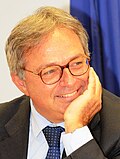 |
|---|
|
The Politics of Marche , Italy takes place in a framework of a semi-presidential representative democracy, whereby the President of the Region is the head of government, and of a pluriform multi-party system. Legislative power is vested in the Regional Council, while executive power is exercised by the Regional Government led by the President, who is directly elected by the people. The current Statute, which regulates the functioning of the regional institutions, has been in force since 2004.
Contents
- Executive branch
- List of presidents
- Legislative branch
- Local government
- Provinces
- Municipalities
- Parties and elections
- Latest regional election
- Notes
- References
- External links
Prior to the rise of Fascism, most of the deputies elected in Marche were part of the liberal establishment (see Historical Right, Historical Left and Liberals), which governed Italy for decades. The region, especially its northern part (largely inhabited by Romagnoli ), was also a stronghold of the Italian Republican Party. In the 1919 general election Marche was one of the regions in which the Italian People's Party, while in the 1924 general election the National Fascist Party took more than 60%. [1]
After World War II Marche was an early stronghold of Christian Democracy and later one of the few regions where the Christian Democrats and the Italian Communist Party were close in terms of the popular vote. However, from 1970 to 1995 the Italian Socialist Party teamed up with the Christian Democrats and long held the presidency, leaving the Communists out of the regional government. Since 1995 the region has been a stronghold of the post-Communist parties, from the Democratic Party of the Left to the present-day Democratic Party, and became part of the so-called "Red belt", along with Emilia-Romagna, Tuscany and Umbria. [2] [3] [4]






